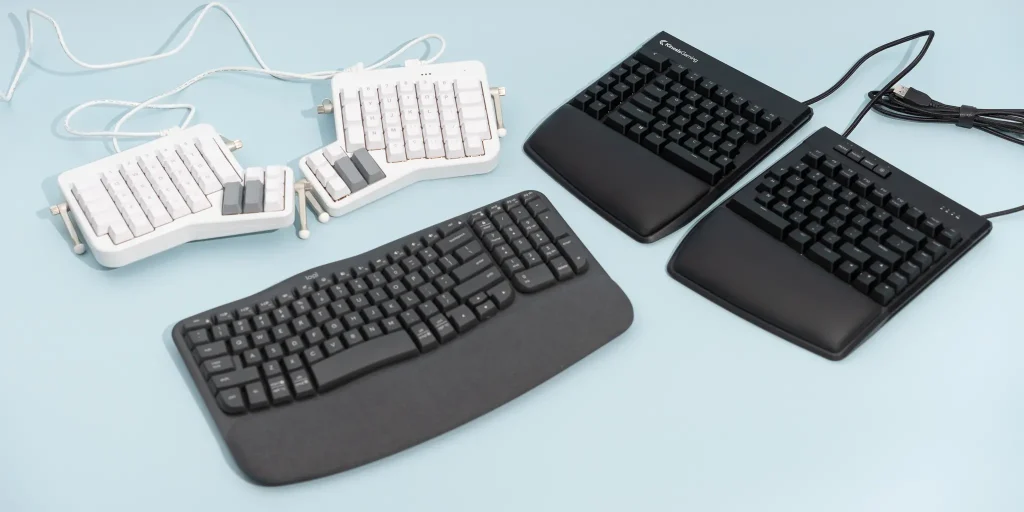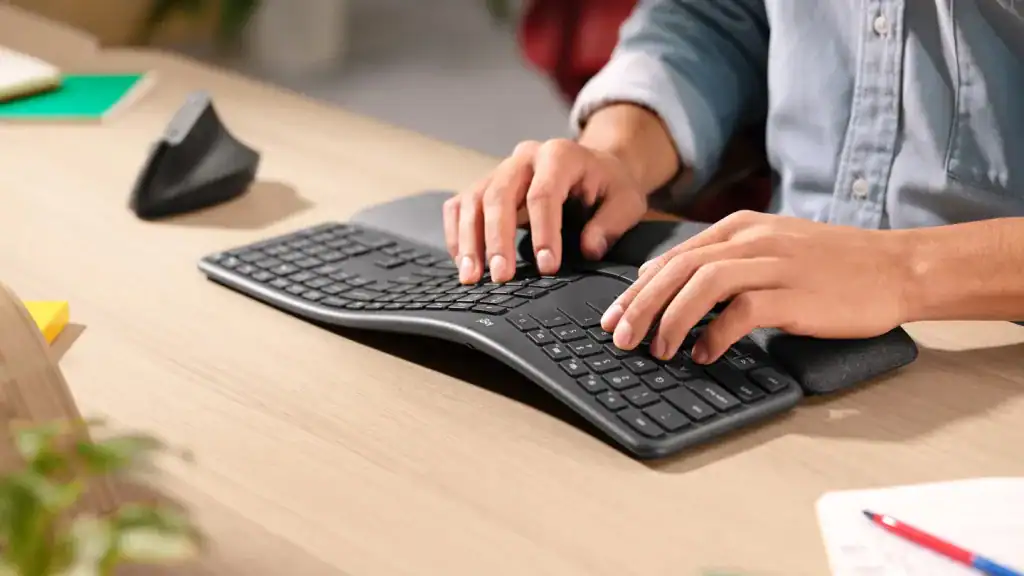Table of Contents

Typing on a keyboard for many hours can lead to wrist pain, repetitive strain injuries (RSIs), and even carpal tunnel syndrome. That’s why ergonomic keyboards are gaining popularity among users who want to protect their health and improve productivity.
Here are the top ergonomic keyboard benefits that will convince you to make the switch.
1. Supports a Natural Typing Position
Ergonomic keyboards are designed to keep your wrists, forearms, and fingers in a natural position. Unlike a standard keyboard that forces your hands into awkward angles, ergo keyboards reduce ulnar deviation, improve wrist posture, and support blood flow.
For example, some ergonomic keyboards tilt slightly or curve outward to keep your arms in a neutral position. By reducing ulnar deviation (the outward bending of the wrists) and avoiding unnatural positions, these keyboards help maintain proper blood flow and wrist posture, taking pressure off your forearms.
2. Reduces the Risk of Carpal Tunnel Syndrome
Carpal tunnel syndrome is one of the most common injuries caused by repetitive strain.
Ergonomic keyboards prevent unnatural positions and support your wrists with angled keys, wrist rests, and split keyboard layouts. Over time, this reduces pressure on the nerves in your hands and lowers your risk of developing carpal tunnel.
3. Helps Prevent Repetitive Strain Injuries
Many ergonomic keyboards are built to minimize RSIs that result from long-term use of standard keyboards.
By aligning the home row and keys with your natural finger movements, these boards help reduce muscle stress and create a healthier typing experience.
4. Improves Comfort with Split Keyboard Designs

A split keyboard allows you to adjust each side of the board separately, aligning with your body and computer screen setup. This flexibility prevents awkward wrist angles and helps keep your forearms aligned. Over time, reducing stress on your wrists and forearms can lower the risk of strain and injury.
Split keyboards are among the best ergonomic keyboard models because they adapt to different keyboards, postures, and body types.
5. Many Ergonomic Keyboards Pair Perfectly with an Ergonomic Mouse
The benefits of an ergonomic keyboard multiply when paired with a separate ergo mouse. Together, they create a workstation that reduces workplace stress, supports your arms and wrists, and enhances overall ergonomics.
Users who switch to both tools often find they can spend many hours typing and using a mouse with less pain and greater productivity.
6. Lowers Workplace Stress and Boosts Productivity
Workplace stress isn’t only mental—it can also come from physical tension. Working for long periods on a non-ergonomic keyboard often leads to wrist pain, fatigue, and loss of performance.
Ergonomic products like ergo keyboards reduce these stressors, helping you stay productive and comfortable throughout the day.
7. Improves Overall Well-Being
Beyond preventing pain, ergonomic keyboards contribute to long-term well-being. Features like angled layouts, cushioned wrist supports, and adjustable designs reduce typing injuries and keep your body in better alignment.
Those who invest in ergonomic designs enjoy plenty of benefits, including improved performance, a more comfortable experience, and fewer health issues.
8. Prevents Ulnar Deviation and Other Typing Injuries
Ulnar deviation occurs when your wrists bend outward to fit a standard keyboard, putting stress on your joints and muscles.
Ergonomic keyboards eliminate this problem by supporting your wrists in a straight position. For users who want to prevent long-term injuries, switching to an ergonomic model makes sense.
9. Designed for Comfort and Accuracy
One of the biggest ergonomic keyboard benefits is the way the keys are shaped and positioned.
Most ergonomic keyboards use sculpted or angled keys that reduce finger stretching and support smoother typing. This design not only helps prevent injuries but also improves accuracy and speed over long periods.
10. Customizable Keys for Different Users
Unlike a standard keyboard, many ergonomic models let users adjust, split, or remap keys to fit their preferred style. This customization helps reduce workplace stress by allowing each user to create a desk and keypad layout that matches their natural wrist position.
Customizable key features are especially helpful for those who switch between a PC and a laptop, or who need computer shortcuts for productivity. You’ll notice the difference in comfort when you start typing on your keypad desk!
11. Reduce Typing Noise and Strain
Some ergonomic keyboards are built with keys that require less force to press, reducing stress on your fingers and wrists. This small change makes a big difference during long-term use, as it prevents fatigue and allows you to spend hours typing without discomfort.
Quiet, responsive keys also improve the overall typing experience, especially in shared workplaces.
Why You Should Consider an Ergonomic Keyboard

If you type for long periods on a PC or laptop, we recommend checking out different ergonomic products such as split keyboards and ergo mice. These tools reduce workplace stress, prevent strain, and provide many benefits for long-term use.
By making the switch, you’ll create a more productive workstation, improve your typing experience, and protect your well-being.
Frequently Asked Questions
What is an advantage of an ergonomic keyboard?
An ergonomic keyboard reduces strain by supporting a natural position for your wrists and fingers, lowering the chance of injuries like carpal tunnel syndrome.
Are ergo keyboards good or bad?
Ergo keyboards are a great option for anyone who spends several hours typing. By reducing tension and improving posture, ergonomic keyboards are healthier than standard keyboards.
Are ergonomic keyboards better for your wrist?
Yes. They reduce wrist pain, prevent ulnar deviation, and lower the chance of strain, making them much better for wrist health than standard boards.
Why is ergonomics important for keyboarding?
Ergonomics prevents injuries and enhances long-term well-being by allowing users to type comfortably in natural positions.
